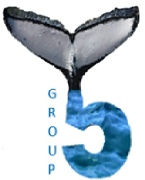Disclaimer: The above statements and veiws are those expressed by the team members of group 5 and do not reflect those of the University of Southampton or the National Oceanography centre staff or other students

Offshore discussion

Aim: to locate the chlorophyll maximum at the tidal mixing front and assess the change in chemical composition of the water column as we move further from shore
We were able to locate the chlorophyll maximum at the tidal mixing front, occurring between station 8 and 11. It occurred at a depth of approximately 25-30m due to a nutrient peak. The silicon and nitrogen peaked at this depth across all stations. Phosphate declined at this depth at stations 5 and 6 but peaked at station 7. This station was the furthest offshore so the chemistry may be different, as it has not been disrupted by coastal processes as much as the inshore stations. Chlorophyll observed is representative of this nutrient peak. It is in low concentrations in the upper surface water due to nutrient depletion. Below the first few metres of the surface water the nutrients are remineralised.
At station 5 nitrate and silicon are highest at 27m and at this point the chlorophyll maximum is observed. Where the nitrate and silicon peak, phytoplankton is at its highest and is dominated by diatoms. This could be due to the availability of a nitrate. Phytoplankton require nitrate for amino acids and building proteins. If nitrogen is limiting nitrogen phytoplankton growth is limited. Diatoms are composed of silicon frustule. high silicon and diatom concentration may be due to near shore nutrients raising the silicon concentration when the phytoplankton assimilate. Phosphate decreased prior to the chlorophyll maximum and increased post the maximum. It is possible this is due to the remineralisation of phytoplankton detritus leading to an increase in phosphate in the deeper water column.
Estuary
Discussion